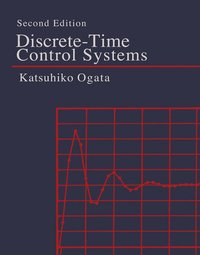
endast ny
Discrete-Time Control Systems Upplaga 2
A comprehensive treatment of the analysis and design of discrete-time control systems which provides a gradual development of the theory by emphasizing basic concepts and avoiding highly mathematical arguments. The book features comprehensive treatment of pole placement, state observer design, and quadratic optimal control.
FEATURES:
In-depth discussions of selected topics (such as Z transform, and pole placement when the control signal was a vector quantity) have been moved to optional Appendices. discusses in detail the theoretical background for designing control systems. offers a greatly expanded treatment of the pole placement design with minimum-order observer by means of state space approach (Ch. 6) and polynomial equations approach (Ch. 7). features a new chapter on the polynomial equations approach to the control systems design as an alternative to the design of control systems via pole placement with minimum-order observers. Includes the design of model matching control systems. emphasizes the usefulness of MATLAB for studying discrete-time control systems showing how to use MATLAB optimally to obtain numerical solutions that involve various types of vector-matrix operations, plotting response curves, and system design based on quadratic optimal control. presents many instructive examples and worked-out problems throughout the entire book.
Upplaga: 2a upplagan
Utgiven: 1995
ISBN: 9780130342812
Förlag: Pearson
Format: Häftad
Språk: Engelska
Sidor: 760 st
A comprehensive treatment of the analysis and design of discrete-time control systems which provides a gradual development of the theory by emphasizing basic concepts and avoiding highly mathematical arguments. The book features comprehensive treatment of pole placement, state observer design, and quadratic optimal control.
FEATURES:
In-depth discussions of selected topics (such as Z transform, and pole placement when the control signal was a vector quantity) have been moved to optional Appendices. discusses in detail the theoretical background for designing control systems. offers a greatly expanded treatment of the pole placement design with minimum-order observer by means of state space approach (Ch. 6) and polynomial equations approach (Ch. 7). features a new chapter on the polynomial equations approach to the control systems design as an alternative to the design of control systems via pole placement with minimum-order observers. Includes the design of model matching control systems. emphasizes the usefulness of MATLAB for studying discrete-time control systems showing how to use MATLAB optimally to obtain numerical solutions that involve various types of vector-matrix operations, plotting response curves, and system design based on quadratic optimal control. presents many instructive examples and worked-out problems throughout the entire book.
Ny bok
2378 kr2503 kr
5% studentrabatt med Studentapan
Begagnad bok (0 st)
Varje vecka tillkommer tusentals nya säljare. Bevaka boken så får du meddelande när den finns tillgänglig igen.



